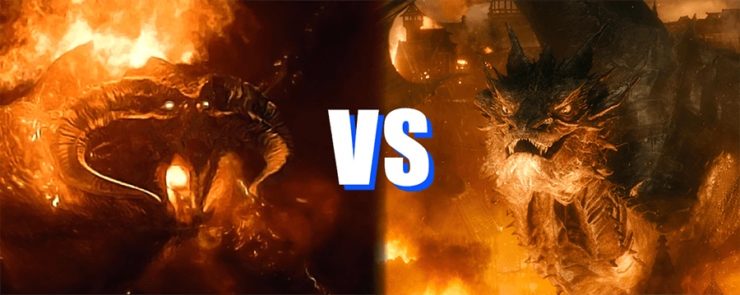No question animates the mind of a young speculative fiction fan more than “Who would win?” It’s a question that provokes our firmest cultural loyalties and the lizard part of our brain that enjoys nothing more than smashing action figures together. It’s a question that’s lead to untold hours of heated discussion, ruined hundreds of friendships, and earned billions of dollars at the box office with movies like Captain America: Civil War and Batman v Superman. It’s hardly a new phenomenon either: King Kong and Godzilla first faced off in 1962, and it’s easy to imagine that the earliest versions of The Iliad arose from heated debates over campfires about who’d win in a fight, Achilles or Hector.
One cultural phenomenon that’s largely escaped “Who Would”-ism is the legendarium of J.R.R. Tolkien. Peter Jackson’s Hobbit trilogy gave us a few battles we didn’t know we wanted, and still don’t (Legolas vs. Bolg; Thranduil vs. The Scenery). Sure, there have been a few articles imagining Aragorn facing off against Jaime Lannister and the like, but they’re relatively rare compared to the heated “Captain America vs. Batman” or “Ninjas vs. Pirates” discussions that pop up regularly over pizza and pipe-weed.
There are a couple of reasons for this. First, Middle-earth has a certain literary cachet other pop cultural universes lack. Tolkien was a professor at Oxford, of course, and The Lord of the Rings is a foundational text of High Fantasy, and retains a lofty air. Second, the central characters of Tolkien’s most widely read books are the diminutive and good-natured hobbits, who are hard to press into the service of battling other heroes. There’s not much fun to be had in imagining Frodo Baggins locked in a fight to the death with a pre-Hogwarts Harry Potter (Frodo would win … and feel absolutely terrible about it).
Still, Middle-earth is rife with interesting match-ups and none more so than a battle between the last surviving Dark Powers of Fire in the Third Age: What if Smaug had sought the treasures of Moria rather than Erebor, and so woke Durin’s Bane? Who would win?
TO THE MYTHOPOEIC THUNDERDOME!
First, let’s introduce our contenders:
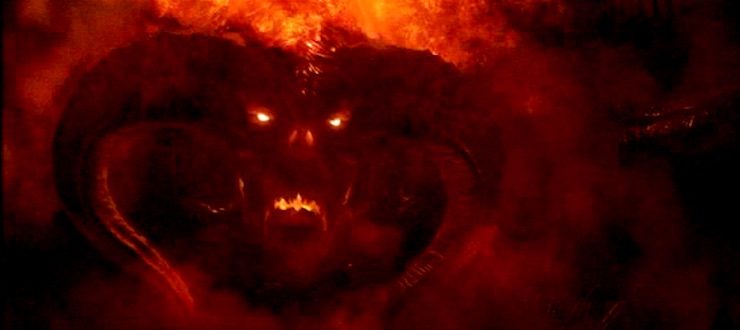
Balrogs and dragons both originated in the First Age as servants of Morgoth, the first and greatest Dark Lord. Of the Maiar spirits Morgoth seduced to his service, “Dreadful … were the Valaraukar, the scourges of fire that in Middle-earth were called the Balrogs, demons of terror.”
As Legolas later says of the Balrog in Moria, Balrogs are “of all elf-banes the most deadly, save the One who sits in the Dark Tower.” And indeed, in The Silmarillion, the Balrogs rank above all Morgoth’s servants, aside from Sauron himself. Their primary narrative purpose in The Silmarillion and The Lord of the Rings is to provide an appropriately noble and titanic death for the greatest heroes: Feanor, Fingon, Ecthelion, Glorfindel, and Gandalf the Grey all meet their ends in combat with these evils of the ancient world (one can’t help but wonder what would have happened had Glorfindel accompanied the Fellowship of the Ring as Elrond originally intended: would he have taken Gandalf’s place in fighting the Balrog on the Bridge of Khazad-dum and shouted “Not this shit again!” instead of “Fly, you fools!” as he tumbled into the abyss?)
The origins of dragons are murkier. Tolkien never tells us how they came to be, though in The Children of Húrin, the first dragon Glaurung, “spoke by the evil spirit that was in him.” It’s likely, then, that the first dragons were Maia spirits animating mortal bodies—like Wizards, but with scales and fire (think how much more effective Radagast would have been as an enormous, flaming horror reptile).
As in George R.R. Martin’s A Song of Ice and Fire, Tolkien’s dragons serve as weapons of mass destruction—and, in fact, in the earliest versions of Tolkien’s legendarium, the “dragons” that destroy the Elven city of Gondolin are war machines, not actual creatures. Tolkien eventually changed them to match the more familiar image of the dragon of Western folklore, though the dragons of Middle-earth are also highly intelligent, sardonic, and enjoy fucking with people. Glaurung sows destruction in The Silmarillion with both his fiery breath and his skill at mind-control and manipulation. He hypnotizes Túrin Turambar and his sister Nienor into committing incest and then suicide, which is a dick move even for a lizard from hell.
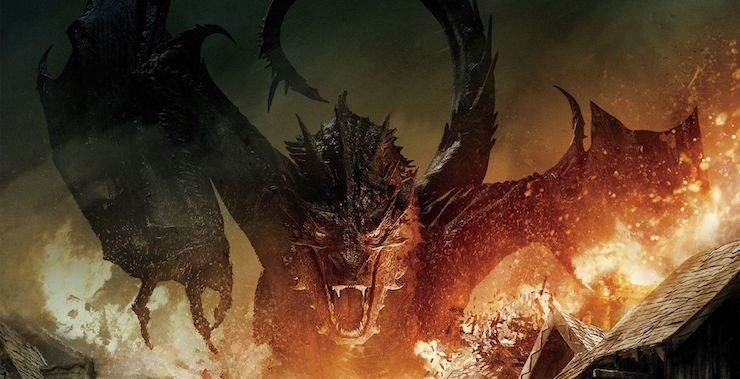
Now, how do they stack up?
The texts don’t provide much evidence for our battle. Dragons and Balrogs never face off in Middle-earth, though they are present together at a few battles during the First Age. When Glaurung first comes forth in the Battle of Sudden Flame, “in his train were Balrogs.” This suggests the Balrogs were subservient to Glaurung, or at least acting as his support.
More tellingly, in the War of Wrath that brings an end to Morgoth’s reign and the First Age, “the Balrogs were destroyed, save some few that fled and hid themselves in caverns inaccessible at the roots of the earth.” The release of the winged dragons—Smaug’s ancestors—however, was “so sudden and ruinous…that the host of the Valar were driven back.” Tolkien doesn’t provide the number of dragons or Balrogs here, so we can’t know how much the sheer quantity of Balrogs and dragons played a part. Still, the dragons proved more effective in battle.
Then there’s Gandalf the Grey, who managed to kill a Balrog single-handed, but decided to manipulate some Dwarves and one very reluctant hobbit into dealing with Smaug. Granted, Gandalf didn’t set out to face a Balrog, and he died in the process (…he got better), but it’s telling that he didn’t even try to take down Smaug by himself. Of course, the Gandalf the Grey in The Hobbit is, in many ways, a different character from the Gandalf the Grey in The Lord of the Rings—as different, really, as he is from Gandalf the White. In The Hobbit, he’s a different, less powerful incarnation of the same being.
So we’re left to our overexcited imaginations to imagine how this fight would play out. And thank Eru for that—it’s far more fun:
So, the first thing any self-respecting wyrm is going to do is unleash his fiery breath—but this wouldn’t phase a scourge of fire like a Balrog.
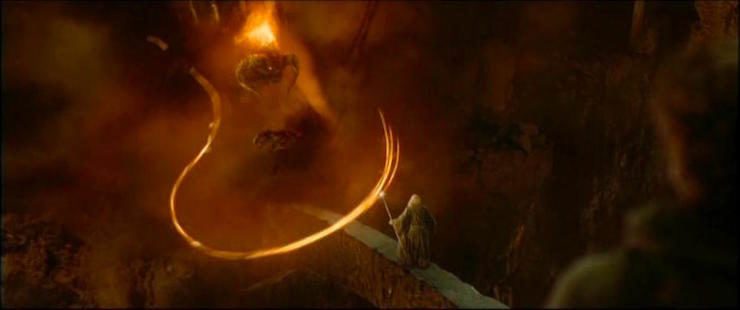
Balrogs have a few weapons available to them: flaming swords, whips of many thongs, and magic. A flaming sword probably isn’t much good against a dragon, and spells don’t seem to work well on them either: the Elves of Nargothrond surely had magic to spare, but that didn’t stop Glaurung from turning their fortress-home into his own personal Scrooge McDuck-style money vault.
That leaves the Balrog with his whip of many thongs, which he could use to hogtie Smaug. Except that Smaug’s “teeth are swords, my claws spears”, and could cut through the thongs. Even if the Balrog’s whips are impervious to dragon teeth and claws, Smaug can quickly flap his wings and fly out of range.
Now, I know what you’re going to say: but Balrogs have wings! Sure, they have wings. But so do ostriches, and you don’t see them flocking high in the skies over Africa. Even if Balrogs can fly—and nothing Tolkien ever wrote indicates that they can—then they clearly suck at it. Of the few Balrogs we know about, two fell into chasms—Durin’s Bane and the one defeated by Glorfindel. That is not a promising record for winged demons of terror.
So Smaug can keep a healthy distance from his demonic opponent, but that doesn’t help him win. More importantly, flight leaves Smaug vulnerable. It exposes the small bare patch on his underbelly—his only weakness. Balrogs are great warriors, and even if they fly about as well as dead penguins, they can probably hurl a flaming sword with pinpoint accuracy.
Smaug stays on the ground. The dragon’s flames and the Balrog’s weapons are useless. We’re down to grappling, with the great wyrm and the demon of terror locked in a desperate, deathly, fiery embrace.
But wait! Smaug has one last weapon: his eyes. We don’t know if Smaug could freeze people and mind-control them as well as his forebear Glaurung, but just glimpsing Smaug’s eye made Bilbo want “to rush out and reveal himself and tell all the truth to Smaug. In fact he was in grievous danger of coming under the dragon-spell.”
Theoretically, then, up close or at a distance, Smaug’s eyes can put Durin’s Bane under the dragon-spell. But then, would the dragon-spell work against a demon of terror?
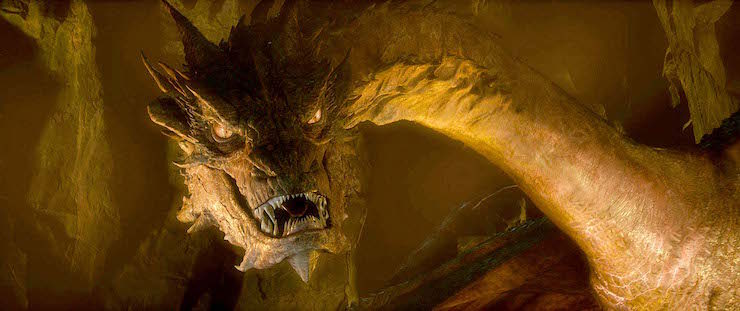
Dragons and Balrogs are both, in origin, Maia spirits. Smaug isn’t Maiar, but his power is equivalent. And we know the power of one Maia can affect other Maiar. After all, Sauron’s Ring is a terrible temptation to both Gandalf and Saruman. And in the Chamber of Mazarbul, Gandalf and Durin’s Bane exchange spells and counterspells that the wizard says, “nearly broke me.”
So, one glimpse into Smaug’s eyes and the Balrog falls under the spell. Even if it’s just for a second—a moment of hesitation or distraction, it’d be enough. Smaug would snatch up Durin’s Bane and gobble him up with his sword-sharp teeth (and we know swords can kill Balrogs).
There you have it. Who would win in a battle between Smaug and Durin’s Bane? The winner is the wyrm. And we can imagine Smaug curled up comfortably on a bed of mithril deep in Khazad-dûm, triumphant, stronger than ever. And probably a little gassy.
Austin Gilkeson formerly served as The Toast‘s Tolkien Correspondent, and his writing has also appeared at Catapult and Cast of Wonders. He lives outside Chicago with his wife and son.










